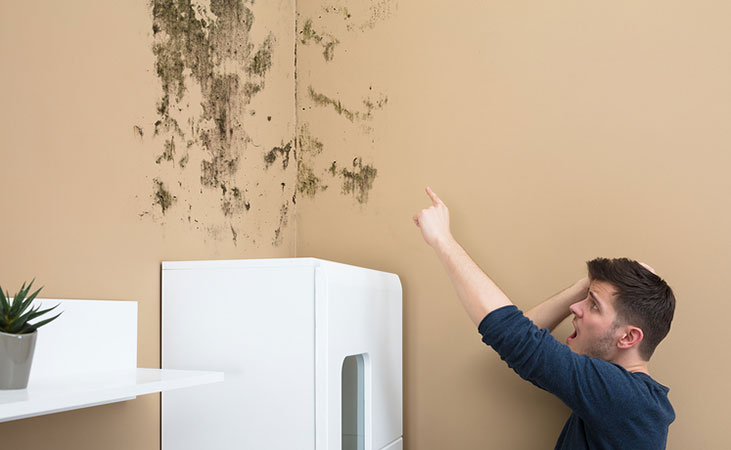Every 5th household in Germany and Austria struggles with mold. There are major health risks associated with this. In this article, we’ll tell you two steps you should take if you never want to have mold infestation in your home again.
In advance, you should know what conditions are necessary for mold to develop in the first place:
- High humidity
- Cold surface.
If one of the two conditions is missing, the mold has no chance. What does that mean to you?
The adjusting screw is in the cold surfaces
You don’t have to run out and buy a dehumidifier right away. On the contrary – relatively high humidity is important for the human body.
The opinions of health experts differ here, but the ideal value settles at 50-60% humidity. If it is lower, human mucous membranes lose moisture and infections can occur.
It makes much more sense that you dedicate yourself to the cold surfaces and fight them. Find out how you can do that below!
Step 1: Temper all rooms, even if they are not in use!
A much common mistake is to heat only occupied areas. The reason for this is the supposed savings in heating costs. Often unheated rooms include, for example, basement rooms.
It is precisely in the living areas, where there is no heating, it can very easily lead to mold growth. The high humidity and cold wall surfaces cause condensation. Mold spores have an easy game there and multiply.
In addition, basement compartments are in some cases already susceptible to moisture due to the building fabric and external conditions. Mold is then pre-programmed.
Do not heat the air, but temper the walls
The first step you can take in this case is regular heating. Even if the rooms are used relatively infrequently, this will give you a comfortable temperature level and allow walls to warm up.
The important thing here is that the walls are heated, not just the air. The next step shows how this works.
Step 2: Heat with the right heater!
When heating the room, there is one more point to consider. To avoid the mold on the wall, the walls must be tempered. Heating the air alone is not enough.
Especially in buildings with thick masonry, it can take up to days for the walls to warm up. The reason for this are the radiators.
Classic radiators work by convection heat. In the process, the surrounding air is heated. It rises to the ceiling and sinks again as soon as it cools down. There the process starts all over again.
Uniform heating of all walls is not possible, because the heat rises primarily to the ceiling. Thus, it can happen that even after long heating periods, some walls still feel cool.
Full-surface temperature control prevents mold growth
How can you overcome this challenge? By tempering all surfaces. Practice shows that panel heating is already very popular in new construction and renovation. Underfloor heating is now installed in every second new building.
Underfloor heating systems are much better in their results than radiators. However, you cannot completely eliminate mold until you also temper the walls and/or ceiling.
Only then will you actually have all surfaces under control. And mold, despite possibly high moisture content, cannot settle on cool surfaces.
Your additional benefit: You save energy & costs!
A positive side effect of panel heating is that you save energy. Due to the large heating surfaces, the heating system works more efficiently and requires lower system temperatures.
Your wallet will be happy about it, because it is also less burdened.
Conclusion: mold does not have to be!
Mold on the wall is annoying and can cost you a lot of nerves. But more concerning is the associated health risk.
The aggressive fungus can cause respiratory infections, asthma and many other diseases in residents.
With panel heating, the surfaces can be heated in a very cheap and simple way. Mold, which requires moisture and a cool surface to grow, thus has no chance to settle.
Our panel heating is energy-saving and does not give mold a chance. If you also want to benefit from energy-saving and mold-repellent panel heating, click here.
Yes, I would like to benefit from energy-saving and mold-repellent panel heating.
Photo: Andrey Popov – fotolia.com



 Wir sind Annette & Christian Egger. Hier im Blog erklären wir Ihnen, worauf es beim Wohlfühl-Klima ankommt. Wir behandeln hier Themen wie Energie-Sparen beim Heizen & Kühlen und zeigen Ihnen unsere interessantesten Projekte.
Wir sind Annette & Christian Egger. Hier im Blog erklären wir Ihnen, worauf es beim Wohlfühl-Klima ankommt. Wir behandeln hier Themen wie Energie-Sparen beim Heizen & Kühlen und zeigen Ihnen unsere interessantesten Projekte. 